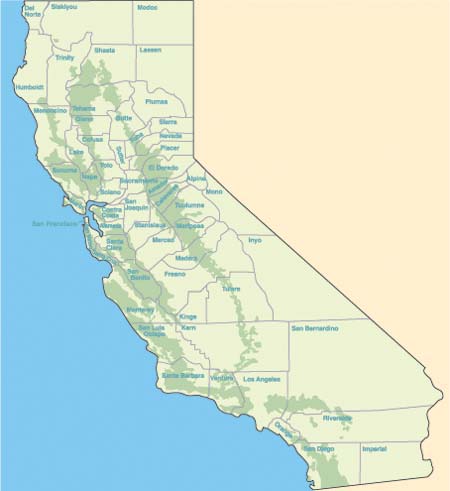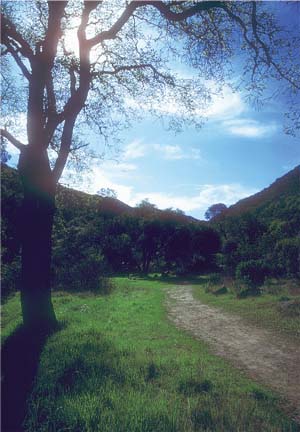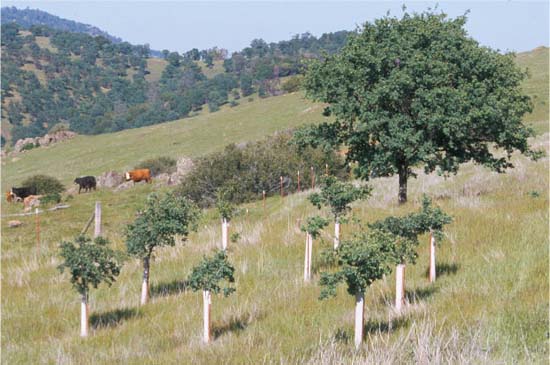All Issues
Oaks: Research and outreach to prevent woodland loss
Publication Information
California Agriculture 61(1):7-10.
Published January 01, 2007
PDF | Citation | Permissions
Abstract
The UC Integrated Hardwood Range Management Program (IHRMP) was born 20 years ago out of controversy over managing California's 10 million acres of oak woodlands. Back then, major concerns included poor oak regeneration and ongoing woodland losses. “The question was, what to do about it?” says IHRMP director James Bartolome, a UC Berkeley range ecologist. “State regulation or research and outreach?” The California legislature opted for the latter and established the IHRMP in October 1986.
Full text
Research and outreach to prevent woodland loss
Oak woodlands provide critical habitat for California native species, including 2,000 plants, 5,000 insects, 160 birds and 80 mammals. Above, a mule deer feeds on seedlings and other plants.
IHRMP is a collaboration among UC, the California Department of Forestry and Fire Protection, and the California Department of Fish and Game. “The program encourages stewardship of oak woodlands as functioning ecosystems,” says former IHRMP manager Rick Standiford, now ANR associate vice president.
Oak woodland losses
While poor regeneration is no longer the pressing concern it was when IHRMP was established, the loss of oak woodlands is a bigger concern than ever. More than four-fifths of California's oak woodlands are privately owned, and with today's rising land values they can be worth far more when used for intensive agriculture or housing than for rangeland. Along the Central Coast, for example, oak woodlands are up to 10 times more profitable when planted in wine grapes and 100 times more profitable when developed for housing. According to a 2001 estimate, more than 30,000 acres of oak woodlands are now converted each year, up steeply from the mid-1980s to mid-1990s when losses were estimated at 60,000 acres for the entire decade.
IHRMP research has demonstrated the ecological impact of oak woodland conversions. Clearing the land for grapes, particularly on steep hillsides, can degrade water quality. And subdividing large parcels into ranchettes and housing developments degrades wildlife habitat. For example, in Sonoma County, there are more nonnative plants and fewer native birds in 10-to-40-acre ranchettes than in large parcels, according to a 1998 study led by Adina Merenlender of the UC Hopland Research and Extension Center. Ranchettes are increasingly popular around the state; in Nevada County, the average parcel size shrank from 550 acres in 1957 to just nine acres in 2001.
To share these findings with landowners, IHRMP offers workshops and publications such as the 180-page Guidelines for Managing California's Hardwood Rangelands, which covers how to keep oak woodlands both protected and profitable. “Many large landowners want to do the right thing, but they need information and help,” says former IHRMP director Douglas McCreary.
This is borne out by surveys of workshop participants. “Their management strategies have incorporated the importance of oak woodland habitat and riparian zones,” ANR's Standiford says.
California native oaks
California has 19 native oaks ranging from the huckleberry oak, a mountain shrub that reaches only a few feet tall, to the valley oak, which may be the largest in North America with trunks up to 7 feet across and canopies up to 100 feet tall. Oaks are divided in three groups: the white group has light wood and rounded leaves or lobes, and includes valley and blue oaks; the red group has reddish-brown wood and leaves with spines or bristles, and includes coast live and California black oaks; and the intermediate group has a mix of these characteristics, and includes huckleberry and canyon live oaks.
The state of California defines oak woodlands as areas with more more than 10% oak canopy cover, and identifies eight oak woodland regions, with the largest regions in the Sierra Nevada foothills at 2.1 million acres, and along the North and Central coasts at 2.1 and 1.9 million acres, respectively. Both the oak species and their threats vary by region. For example, in the Sierra Nevada foothills, the dominant species include blue, black and interior live oak, and the threats include conversion to vineyards and ranchettes. In the Central Coast, the dominant species include valley, blue and coast live oak, and the threats include conversion to intensive agriculture and sudden oak death ( see page 9 ).
IHRMP research has increased our understanding of the ecological value of oak woodlands, McCreary says. These habitats are among the most critical for California's native species, including some 2,000 plants as well as 5,000 insects, 80 amphibians and reptiles, 160 birds and 80 mammals. Oak woodlands are also key to water quality. As snowmelt flows down watersheds and into streams and rivers, oaks keep the soil in place to prevent erosion and stream sedimentation.
“Oak woodlands are often taken for granted but they need to be managed and conserved,” says McCreary, an oak regeneration expert at the UC Sierra Foothill Research and Extension Center in Browns Valley.
Exclosures protect saplings
Poor regeneration is most common in three white oaks (blue, valley and Englemann) found mostly in the foothills of the Sierra Nevada, coast ranges and transverse ranges, which extend from Santa Barbara to the Mojave Desert. Typically, areas with poor regeneration have seedlings and mature trees but few saplings, which means most of the mature trees will not be replaced naturally when they die. IHRMP researchers have helped figure out why these young oaks are in trouble. Oaks are most susceptible during the transition from seedling to sapling, and the main threats include overgrazing by cattle and deer, and competition from the nonnative annual grasses that have replaced native perennial grasses.
IHRMP researchers have also helped figure out how to help more young oaks survive these threats. “We led the effort to develop artificial regeneration techniques,” McCreary says. Successful approaches include controlling weeds and protecting seedlings from herbivores with shelters. The work is ongoing, with retired UC livestock advisor Ralph Phillips and colleagues recently showing that older blue oak seedlings are far more likely to survive than those that have just sprouted and that blue oak seedlings grow better in 2-or 4-foot “exclosures” ( see pages 11 and 16 ).
To help landowners and managers restore oak woodlands, McCreary wrote Regenerating Rangeland Oaks in California. This 62-page guidebook includes step-by-step instructions on everything from transplanting seedlings to protecting them. “It's the only ‘how-to’ manual there is,” he says.
IHRMP also organizes symposia every few years that cover the latest research on California's oaks. The sixth and most recent California Oak Symposium was held in Rohnert Park from Oct. 9 to 12, 2006, and featured sessions on issues from tree health to oak woodland stewardship and planning.
Distribution of oak woodlands and forests in California (shaded area). Source: Allen-Diaz B, Standiford R, Jackson RD. 2007 (in press). In: Terrestrial Vegetation of California. Berkeley, CA: UC Press.
California's 10 million acres of oak woodlands are threatened primarily by land conversions to intensive agriculture and housing, and poor regeneration. Researchers can study oak habitat at the UC Natural Reserve System's Stebbins Cold Canyon Reserve in Solano and Napa counties.
Simple protections, such as fencing and plastic treeshelters (shown at the UC Sierra Foothill Research and Extension Center), can improve the survival of oak seedlings in areas heavily grazed by cattle and deer.
Conservation is key
While California is losing more acres of oak woodlands now than before IHRMP was established, the state is also conserving more acres. To facilitate oak woodland preservation, IHRMP helps local jurisdictions implement conservation easements. These typically limit development while allowing grazing and other sustainable uses, and give landowners financial benefits such as lower property taxes. “Land values have gone up so much. We need financial incentives for landowners to provide the public with services like watersheds and wildlife habitat,” Standiford says. State funding sources for conservation easements include the 2001 Oak Woodland Conservation Act (AB 242), and IHRMP worked on the guidelines for dispensing funds as well as on the local Oak Management Plans required to secure them.
Most recently, IHRMP has shifted its outreach focus to land planners and policymakers. This is because oak woodlands are now regulated by various jurisdictions. “Many cities and counties have adopted ordinances and we help people meet these requirements,” program director Bartolome says. At the state level, the 2004 Oak Woodlands Conservation: Environmental Quality Act (SB 1334) requires that “significant effects” on oak woodlands be mitigated with measures ranging from conservation easements to oak plantings. Moreover, the law requires monitoring to ensure the mitigation's success.
In December, IHRMP will offer the first in a series of Oak Woodland Planner's Workshops in Auburn, a fast-growing part of the Sierra Nevada foothills. The topics include implementing state laws that affect oak woodlands, and strategies for conserving them. Planning approaches include protecting large tracts of oak woodland by, for example, clustering rural developments, containing sprawl with urban growth boundaries, and minimizing invasive, nonnative plants in rural residential areas.
“We help preserve, protect and provide alternatives for oak woodlands,” Bartolome says. “It's important to give people viable options.”









